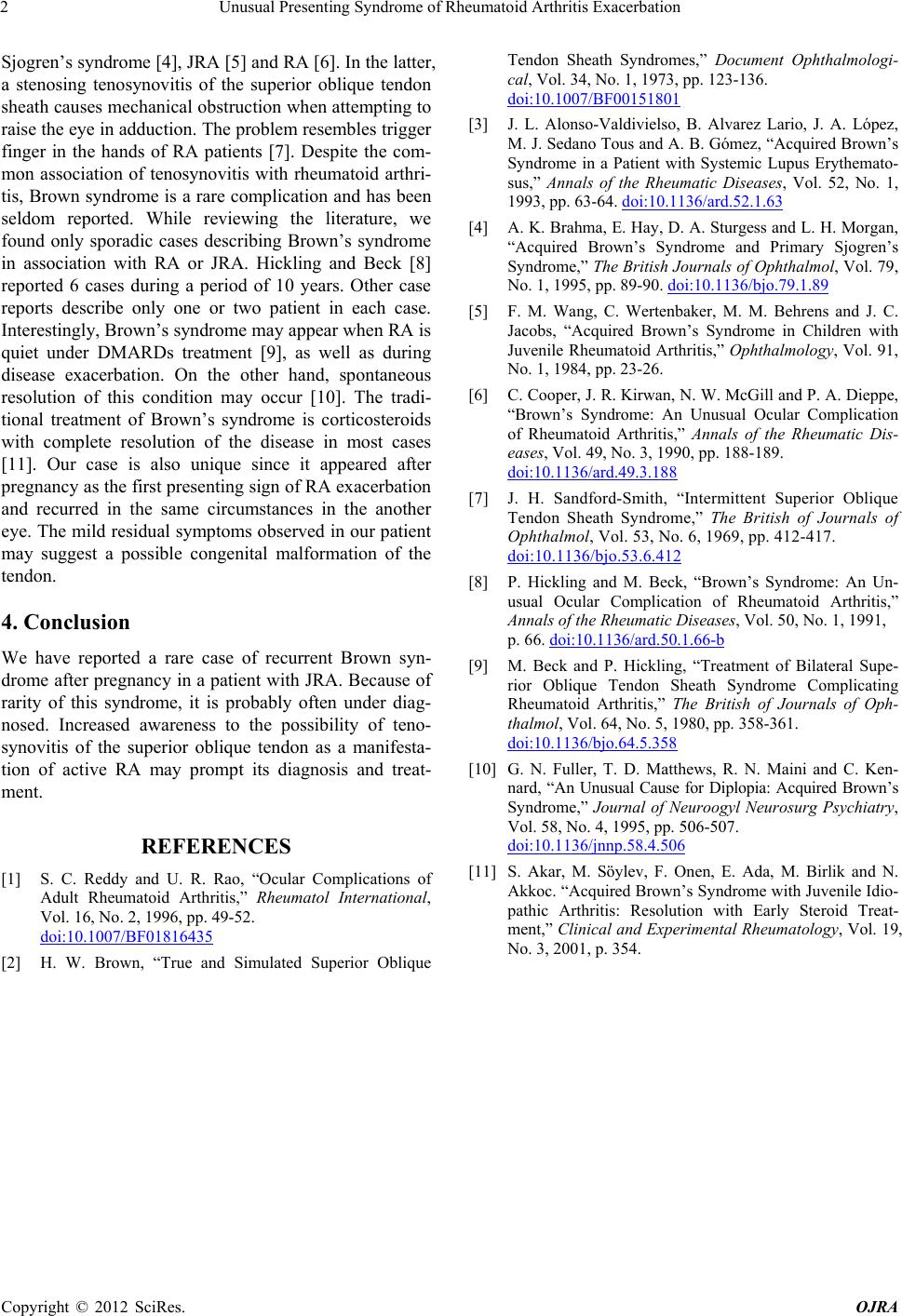
Unusual Presenting Syndrome of Rheumatoid Arthritis Exacerbation
2
Sjogren’s syndro me [4], JRA [5] and RA [6]. In the latter,
a stenosing tenosynovitis of the superior oblique tendon
sheath causes mechanical obstruction when attempting to
raise the eye in adduction. The problem resembles trigger
finger in the hands of RA patients [7]. Despite the com-
mon association of tenosynovitis with rheumatoid arthri-
tis, Brown syndrome is a rare complication and has been
seldom reported. While reviewing the literature, we
found only sporadic cases describing Brown’s syndrome
in association with RA or JRA. Hickling and Beck [8]
reported 6 cases during a period of 10 years. Other case
reports describe only one or two patient in each case.
Interestingly, Brown’ s syndrome may app ear when RA is
quiet under DMARDs treatment [9], as well as during
disease exacerbation. On the other hand, spontaneous
resolution of this condition may occur [10]. The tradi-
tional treatment of Brown’s syndrome is corticosteroids
with complete resolution of the disease in most cases
[11]. Our case is also unique since it appeared after
pregnancy as the first presenting sign of RA exacerbation
and recurred in the same circumstances in the another
eye. The mild residual symptoms observed in our patient
may suggest a possible congenital malformation of the
tendon.
4. Conclusion
We have reported a rare case of recurrent Brown syn-
drome after pregnancy in a patient with JRA. Because of
rarity of this syndrome, it is probably often under diag-
nosed. Increased awareness to the possibility of teno-
synovitis of the superior oblique tendon as a manifesta-
tion of active RA may prompt its diagnosis and treat-
ment.
REFERENCES
[1] S. C. Reddy and U. R. Rao, “Ocular Complications of
Adult Rheumatoid Arthritis,” Rheumatol International,
Vol. 16, No. 2, 1996, pp. 49-52.
doi:10.1007/BF01816435
[2] H. W. Brown, “True and Simulated Superior Oblique
Tendon Sheath Syndromes,” Document Ophthalmologi-
cal, Vol. 34, No. 1, 1973, pp. 123-136.
doi:10.1007/BF00151801
[3] J. L. Alonso-Valdivielso, B. Alvarez Lario, J. A. López,
M. J. Sedano Tous and A. B. Gómez, “Acquired Brown’s
Syndrome in a Patient with Systemic Lupus Erythemato-
sus,” Annals of the Rheumatic Diseases, Vol. 52, No. 1,
1993, pp. 63-64. doi:10.1136/ard.52.1.63
[4] A. K. Brahma, E. Hay, D. A. Sturgess and L. H. Morgan,
“Acquired Brown’s Syndrome and Primary Sjogren’s
Syndrome,” The British Journals of Ophthalmol, Vol. 79,
No. 1, 1995, pp. 89-90. doi:10.1136/bjo.79.1.89
[5] F. M. Wang, C. Wertenbaker, M. M. Behrens and J. C.
Jacobs, “Acquired Brown’s Syndrome in Children with
Juvenile Rheumatoid Arthritis,” Ophthalmology, Vol. 91,
No. 1, 1984, pp. 23-26.
[6] C. Cooper, J. R. Kirwan, N. W. McGill and P. A. Dieppe,
“Brown’s Syndrome: An Unusual Ocular Complication
of Rheumatoid Arthritis,” Annals of the Rheumatic Dis-
eases, Vol. 49, No. 3, 1990, pp. 188-189.
doi:10.1136/ard.49.3.188
[7] J. H. Sandford-Smith, “Intermittent Superior Oblique
Tendon Sheath Syndrome,” The British of Journals of
Ophthalmol, Vol. 53, No. 6, 1969, pp. 412-417.
doi:10.1136/bjo.53.6.412
[8] P. Hickling and M. Beck, “Brown’s Syndrome: An Un-
usual Ocular Complication of Rheumatoid Arthritis,”
Annals of the Rheumatic Diseases, Vol. 50, No. 1, 1991,
p. 66. doi:10.1136/ard.50.1.66-b
[9] M. Beck and P. Hickling, “Treatment of Bilateral Supe-
rior Oblique Tendon Sheath Syndrome Complicating
Rheumatoid Arthritis,” The British of Journals of Oph-
thalmol, Vol. 64, No. 5, 1980, pp. 358-361.
doi:10.1136/bjo.64.5.358
[10] G. N. Fuller, T. D. Matthews, R. N. Maini and C. Ken-
nard, “An Unusual Cause for Diplopia: Acquired Brown’s
Syndrome,” Journal of Neuroogyl Neurosurg Psychiatry,
Vol. 58, No. 4, 1995, pp. 506-507.
doi:10.1136/jnnp.58.4.506
[11] S. Akar, M. Söylev, F. Onen, E. Ada, M. Birlik and N.
Akkoc. “Acquired Brown’s Syndrome with Juvenile Idio-
pathic Arthritis: Resolution with Early Steroid Treat-
ment,” Clinical and Experimental Rheumatology, Vol. 19,
No. 3, 2001, p. 354.
Copyright © 2012 SciRes. OJRA